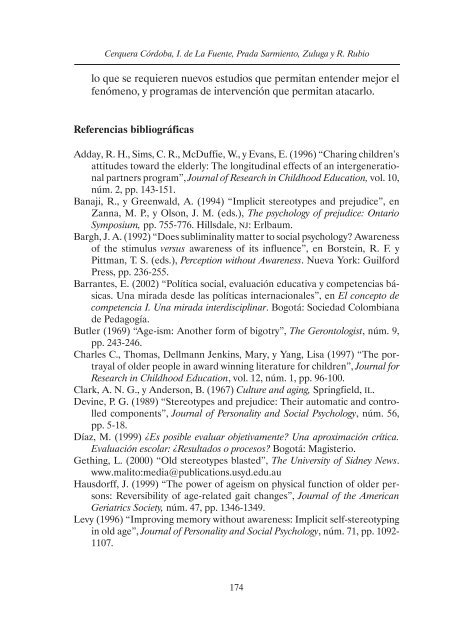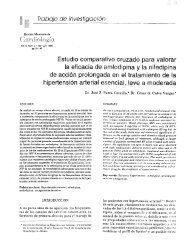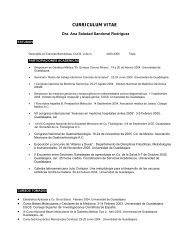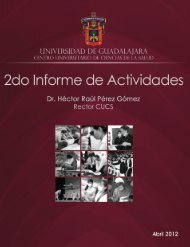Imaginarios <strong>sociales</strong> sobre <strong>el</strong> <strong>en</strong>vejecimi<strong>en</strong>to <strong>en</strong> las mujeres1. En la muestra española se manti<strong>en</strong><strong>en</strong> a niv<strong>el</strong> g<strong>en</strong>eral difer<strong>en</strong>cias<strong>de</strong> género a favor <strong>de</strong> los hombres <strong>en</strong> cuanto al niv<strong>el</strong> educativo, lascuales <strong>de</strong>saparec<strong>en</strong> <strong>en</strong>tre los jóv<strong>en</strong>es, lo cual muestra un cambiofavorable <strong>de</strong> la sociedad <strong>en</strong> este aspecto; estas difer<strong>en</strong>cias no se pres<strong>en</strong>taron<strong>en</strong> la muestra colombiana, don<strong>de</strong> a<strong>de</strong>más <strong>en</strong> la cohorte <strong>de</strong>jóv<strong>en</strong>es hubo una <strong>mayor</strong>ía <strong>de</strong> mujeres con estudios universitarios.2. En la muestra española los <strong>mayor</strong>es <strong>de</strong> 60 años pres<strong>en</strong>taron porc<strong>en</strong>tajesclaram<strong>en</strong>te inferiores <strong>de</strong> conviv<strong>en</strong>cia o cercanía con otro <strong>mayor</strong>;se hace necesario estudiar más profundam<strong>en</strong>te esta situación.3. Como suce<strong>de</strong> <strong>en</strong> los países <strong>en</strong> <strong>de</strong>sarrollo, se pres<strong>en</strong>taron porc<strong>en</strong>tajes<strong>mayor</strong>es <strong>de</strong> conviv<strong>en</strong>cia con un <strong>mayor</strong> <strong>en</strong> la muestra colombiana,a difer<strong>en</strong>cia <strong>de</strong> los países <strong>de</strong>sarrollados, con<strong>de</strong> un alto porc<strong>en</strong>taje <strong>de</strong><strong>adulto</strong>s <strong>mayor</strong>es viv<strong>en</strong> solos.4. En g<strong>en</strong>eral las dos poblaciones estudiadas pres<strong>en</strong>taron <strong>mayor</strong>itariam<strong>en</strong>t<strong>el</strong>os estereotipos positivos sobre la mujer adulta <strong>mayor</strong>, alconsi<strong>de</strong>rar que normalm<strong>en</strong>te es más g<strong>en</strong>erosa, ser<strong>en</strong>a, dulce, sabia,compr<strong>en</strong>siva y más pru<strong>de</strong>nte al conducir.5. En g<strong>en</strong>eral las dos poblaciones consi<strong>de</strong>raron <strong>mayor</strong>itariam<strong>en</strong>te qu<strong>el</strong>a mujer adulta <strong>mayor</strong> pres<strong>en</strong>ta un fuerte <strong>de</strong>terioro <strong>de</strong> la salud, ti<strong>en</strong>em<strong>en</strong>os interés por <strong>el</strong> sexo, pres<strong>en</strong>ta consi<strong>de</strong>rable <strong>de</strong>terioro <strong>de</strong> lamemoria, es m<strong>en</strong>os activa y es <strong>en</strong> muchas ocasiones como una niña.6. No se pres<strong>en</strong>tó una difer<strong>en</strong>cia clara <strong>en</strong>tre hombres y mujeres jóv<strong>en</strong>es<strong>de</strong> las dos muestras; <strong>en</strong> g<strong>en</strong>eral todos pres<strong>en</strong>taron la <strong>mayor</strong>parte <strong>de</strong> estereotipos positivos, que ti<strong>en</strong><strong>de</strong>n a ver a la mujer adulta<strong>mayor</strong> como una persona dulce pero con fuerte <strong>de</strong>terioro <strong>de</strong> la saludy <strong>de</strong> la memoria, a qui<strong>en</strong> no le interesa <strong>el</strong> sexo y es a<strong>de</strong>más rígidae inflexible.7. Los <strong>adulto</strong>s (31-60 años <strong>de</strong> edad), a difer<strong>en</strong>cia <strong>de</strong> esta misma cohorteespañola, mostraron una apar<strong>en</strong>te percepción <strong>de</strong> la mujer adulta <strong>mayor</strong>más <strong>de</strong>svalida, con <strong>mayor</strong> <strong>de</strong>terioro físico y m<strong>en</strong>os autónoma.8. La cohorte <strong>de</strong> <strong>adulto</strong>s <strong>mayor</strong>es <strong>de</strong> la muestra <strong>de</strong> ambos países pres<strong>en</strong>tólas <strong>mayor</strong>es frecu<strong>en</strong>cias <strong>de</strong> acuerdo con los estereotipos <strong>en</strong>cuestados.9. Exist<strong>en</strong>, <strong>en</strong> las dos muestras estudiadas, estereotipos fr<strong>en</strong>te al proceso<strong>de</strong> <strong>en</strong>vejecimi<strong>en</strong>to fem<strong>en</strong>ino y fr<strong>en</strong>te a la mujer adulta <strong>mayor</strong>, por173
Cerquera Córdoba, I. <strong>de</strong> La Fu<strong>en</strong>te, Prada Sarmi<strong>en</strong>to, Zuluga y R. Rubiolo que se requier<strong>en</strong> nuevos estudios que permitan <strong>en</strong>t<strong>en</strong><strong>de</strong>r mejor <strong>el</strong>f<strong>en</strong>óm<strong>en</strong>o, y programas <strong>de</strong> interv<strong>en</strong>ción que permitan atacarlo.Refer<strong>en</strong>cias bibliográficasAdday, R. H., Sims, C. R., McDuffie, W., y Evans, E. (1996) “Charing childr<strong>en</strong>’sattitu<strong>de</strong>s toward the <strong>el</strong><strong>de</strong>rly: The longitudinal effects of an interg<strong>en</strong>erationalpartners program”, Journal of Research in Childhood Education, vol. 10,núm. 2, pp. 143-151.Banaji, R., y Gre<strong>en</strong>wald, A. (1994) “Implicit stereotypes and prejudice”, <strong>en</strong>Zanna, M. P., y Olson, J. M. (eds.), The psychology of prejudice: OntarioSymposium, pp. 755-776. Hillsdale, nj: Erlbaum.Bargh, J. A. (1992) “Does subliminality matter to social psychology? Awar<strong>en</strong>essof the stimulus versus awar<strong>en</strong>ess of its influ<strong>en</strong>ce”, <strong>en</strong> Borstein, R. F. yPittman, T. S. (eds.), Perception without Awar<strong>en</strong>ess. Nueva York: GuilfordPress, pp. 236-255.Barrantes, E. (2002) “Política social, evaluación educativa y compet<strong>en</strong>cias básicas.Una mirada <strong>de</strong>s<strong>de</strong> las políticas internacionales”, <strong>en</strong> El concepto <strong>de</strong>compet<strong>en</strong>cia I. Una mirada interdisciplinar. Bogotá: Sociedad Colombiana<strong>de</strong> Pedagogía.Butler (1969) “Age-ism: Another form of bigotry”, The Gerontologist, núm. 9,pp. 243-246.Charles C., Thomas, D<strong>el</strong>lmann J<strong>en</strong>kins, Mary, y Yang, Lisa (1997) “The portrayalof ol<strong>de</strong>r people in award winning literature for childr<strong>en</strong>”, Journal forResearch in Childhood Education, vol. 12, núm. 1, pp. 96-100.Clark, A. N. G., y An<strong>de</strong>rson, B. (1967) Culture and aging, Springfi<strong>el</strong>d, il.Devine, P. G. (1989) “Stereotypes and prejudice: Their automatic and controlledcompon<strong>en</strong>ts”, Journal of Personality and Social Psychology, núm. 56,pp. 5-18.Díaz, M. (1999) ¿Es posible evaluar objetivam<strong>en</strong>te? Una aproximación crítica.Evaluación escolar: ¿Resultados o procesos? Bogotá: Magisterio.Gething, L. (2000) “Old stereotypes blasted”, The University of Sidney News.www.malito:media@publications.usyd.edu.auHausdorff, J. (1999) “The power of ageism on physical function of ol<strong>de</strong>r persons:Reversibility of age-r<strong>el</strong>ated gait changes”, Journal of the AmericanGeriatrics Society, núm. 47, pp. 1346-1349.Levy (1996) “Improving memory without awar<strong>en</strong>ess: Implicit s<strong>el</strong>f-stereotypingin old age”, Journal of Personality and Social Psychology, núm. 71, pp. 1092-1107.174
- Page 2:
Condiciones socialesy calidad de vi
- Page 6:
ContenidoIntroducción . 11I. ¿Viv
- Page 10 and 11:
IntroducciónEn las últimas décad
- Page 12 and 13:
I¿Vivir más o vivir mejor?Margina
- Page 14 and 15:
¿Vivir más o vivir mejor? Margina
- Page 16 and 17:
¿Vivir más o vivir mejor? Margina
- Page 18 and 19:
¿Vivir más o vivir mejor? Margina
- Page 20 and 21:
¿Vivir más o vivir mejor? Margina
- Page 22:
¿Vivir más o vivir mejor? Margina
- Page 26 and 27:
¿Vivir más o vivir mejor? Margina
- Page 28 and 29:
¿Vivir más o vivir mejor? Margina
- Page 30 and 31:
¿Vivir más o vivir mejor? Margina
- Page 32 and 33:
¿Vivir más o vivir mejor? Margina
- Page 34 and 35:
¿Vivir más o vivir mejor? Margina
- Page 36 and 37:
IIEnvejecimiento demográfico,condi
- Page 38 and 39:
Envejecimiento demográfico, condic
- Page 40 and 41:
mayor en Chile entre 1990 y 2010 ha
- Page 42 and 43:
Envejecimiento demográfico, condic
- Page 44 and 45:
Envejecimiento demográfico, condic
- Page 46 and 47:
Envejecimiento demográfico, condic
- Page 48 and 49:
Envejecimiento demográfico, condic
- Page 50 and 51:
Envejecimiento demográfico, condic
- Page 52 and 53:
Envejecimiento demográfico, condic
- Page 54 and 55:
Envejecimiento demográfico, condic
- Page 56 and 57:
Envejecimiento demográfico, condic
- Page 58 and 59:
Envejecimiento demográfico, condic
- Page 60:
Envejecimiento demográfico, condic
- Page 63 and 64:
María Ana Valle Barbosa y Armando
- Page 65 and 66:
María Ana Valle Barbosa y Armando
- Page 67 and 68:
María Ana Valle Barbosa y Armando
- Page 69 and 70:
María Ana Valle Barbosa y Armando
- Page 71 and 72:
María Ana Valle Barbosa y Armando
- Page 73 and 74:
María Elena Flores Villavicenciola
- Page 75 and 76:
María Elena Flores Villavicencioni
- Page 77 and 78:
María Elena Flores VillavicencioAl
- Page 79 and 80:
María Elena Flores Villavicencioen
- Page 81 and 82:
María Elena Flores Villavicenciode
- Page 83 and 84:
María Elena Flores VillavicencioDe
- Page 86 and 87:
VConcepto de la calidad de vidaen r
- Page 88 and 89:
Concepto de la calidad de vida en r
- Page 90 and 91:
Concepto de la calidad de vida en r
- Page 92 and 93:
Concepto de la calidad de vida en r
- Page 94 and 95:
Concepto de la calidad de vida en r
- Page 96 and 97:
Concepto de la calidad de vida en r
- Page 98 and 99:
VICalidad de vida en adultos mayore
- Page 100 and 101:
Calidad de vida en adultos mayores
- Page 102 and 103:
Calidad de vida en adultos mayores
- Page 104 and 105:
InstrumentosCalidad de vida en adul
- Page 106 and 107:
Calidad de vida en adultos mayores
- Page 108 and 109:
Calidad de vida en adultos mayores
- Page 110 and 111:
Condiciones socialesCalidad de vida
- Page 112 and 113:
Calidad de vida en adultos mayores
- Page 114 and 115:
Calidad de vida en adultos mayores
- Page 116:
Calidad de vida en adultos mayores
- Page 119 and 120:
Marisa Torres H., Reinaldo Rioseco
- Page 121 and 122: Marisa Torres H., Reinaldo Rioseco
- Page 123 and 124: Marisa Torres H., Reinaldo Rioseco
- Page 125 and 126: Marisa Torres H., Reinaldo Rioseco
- Page 127 and 128: Marisa Torres H., Reinaldo Rioseco
- Page 129 and 130: Marisa Torres H., Reinaldo Rioseco
- Page 131 and 132: Marisa Torres H., Reinaldo Rioseco
- Page 133 and 134: Marisa Torres H., Reinaldo Rioseco
- Page 135 and 136: Cerquera Córdoba, Prada Sarmiento
- Page 137 and 138: Cerquera Córdoba, Prada Sarmiento
- Page 139 and 140: Cerquera Córdoba, Prada Sarmiento
- Page 141 and 142: Cerquera Córdoba, Prada Sarmiento
- Page 143 and 144: Cerquera Córdoba, Prada Sarmiento
- Page 145 and 146: Con grupo disciplinarioCerquera Có
- Page 147 and 148: Cerquera Córdoba, Prada Sarmiento
- Page 149 and 150: Cerquera Córdoba, Prada Sarmiento
- Page 151 and 152: Cerquera Córdoba, Prada Sarmiento
- Page 153 and 154: Cerquera Córdoba, Prada Sarmiento
- Page 156 and 157: IXImaginarios socialessobre el enve
- Page 158 and 159: Imaginarios sociales sobre el envej
- Page 160 and 161: Imaginarios sociales sobre el envej
- Page 162 and 163: Imaginarios sociales sobre el envej
- Page 164 and 165: Imaginarios sociales sobre el envej
- Page 166 and 167: Imaginarios sociales sobre el envej
- Page 168 and 169: Imaginarios sociales sobre el envej
- Page 170 and 171: Imaginarios sociales sobre el envej
- Page 174 and 175: Imaginarios sociales sobre el envej
















